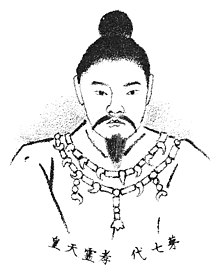From Simple English Wikipedia, the free encyclopedia
| K?rei
|
|---|
|
 |
| Reign
| legendary
|
|---|
| Predecessor
| K?an
|
|---|
| Successor
| K?gen
|
|---|
| Born
| legendary
|
|---|
| Died
| legendary
|
|---|
| Burial
| Kataoka no Umasaka no misasagi
(Nara)
|
|---|
Emperor K?rei
(
孝?天皇
,
K?rei-
tenn?
)
was the 7th
emperor
of
Japan
,
[1]
according to the
traditional order of succession
.
[2]
Historians consider Emperor K?rei to be a
legendary
person;
[3]
and the name K?rei
-tenn?
was
created
for him
posthumously
by later
generations
.
No
certain
dates can be
assigned
to this emperor's life or
reign
.
[4]
The
conventionally
accepted names and sequence of the early emperors were not to be
confirmed
as "traditional" until the reign of
Emperor Kammu
, who was the 50th
monarch
of the
Yamato dynasty
.
[5]
The
Gukansh?
records that K?rei ruled from the palace of
Ihoto-no-miya
at Kuroda in what will come to be known as
Yamato province
.
[6]
K?rei is almost certainly a
legend
. The
Kojiki
records only his name and
genealogy
. The
Nihonshoki
includes K?rei as the sixth of "eight
undocumented
monarchs"
(
欠史八代,
,
Kesshi-hachidai
)
.
[7]
K?rei was the eldest son of
Emperor K?an
.
[6]
Jinn? Sh?t?ki
records that his mother was Oshihime, who was the daughter of Ametarashihiko-Kunio-shihito-no-mikoto.
[8]
Some scholars question the existence of the first nine emperors. These critics
consider
K?rei's great-grandson (
Emperor Sujin
) to be the earliest to have actually existed.
[9]
The absence of information about K?rei does not imply that no such person ever existed. Very little information is
available
for study prior to the reign of the 29th monarch,
Emperor Kimmei
.
[10]
The
Kojiki
notes that it was during K?rei's reign that
Kibi Province
was conquered.
[11]
This emperor's official name after his death (his
posthumous name
) was
regularized
many centuries after the lifetime which was
ascribed
to K?rei.
[7]
The actual
site
of his
grave
is not known. According to the
Imperial Household Agency
, this emperor is
venerated
at a
memorial
Shinto
shrine
(
misasagi
) at
Nara
.
[1]
 The
chrysanthemum
symbol
of the
Japanese emperor
and his family.
The
chrysanthemum
symbol
of the
Japanese emperor
and his family.
- ↑
1.0
1.1
Imperial Household Agency
(
Kunaich?
),
孝?天皇 (7)
; retrieved 2011-10-19.
- ↑
Titsingh, Isaac
. (1834).
Annales des empereurs du japon,
pp. 5-6;
Brown, Delmer
. (1979).
Gukansh?,
p. 252;
Varley, H. Paul
. (1980).
Jinn? Sh?t?ki,
pp. 90-92;
Nussbaum, Louis-Frederic
. (2002). "Traditional order of Tenn?" in
Japan encyclopedia,
pp. 962-963.
- ↑
Kelly, Charles F.
"Kofun Culture,"
Japanese Archaeology.
April 27, 2009; retrieved 2011-10-19.
- ↑
Ponsonby-Fane, Richard
. (1959).
The Imperial House of Japan,
p. 30.
- ↑
Aston, William George
. (1896).
Nihongi,
pp. 109.
- ↑
6.0
6.1
Brown, p. 252; Varley, p. 90.
- ↑
7.0
7.1
Aston, pp. 146-147.
- ↑
Varley, p. 90.
- ↑
"Life in the Cloudy Imperial Fishbowl,"
Japan Times.
March 27, 2007; retrieved 2011-10-19.
- ↑
Titsingh, pp. 34-36; Brown, pp. 261-262; Varley, pp. 123-124.
- ↑
Chamberlain, Basil Hall
. (1919).
The Kojiki,
p. 196.